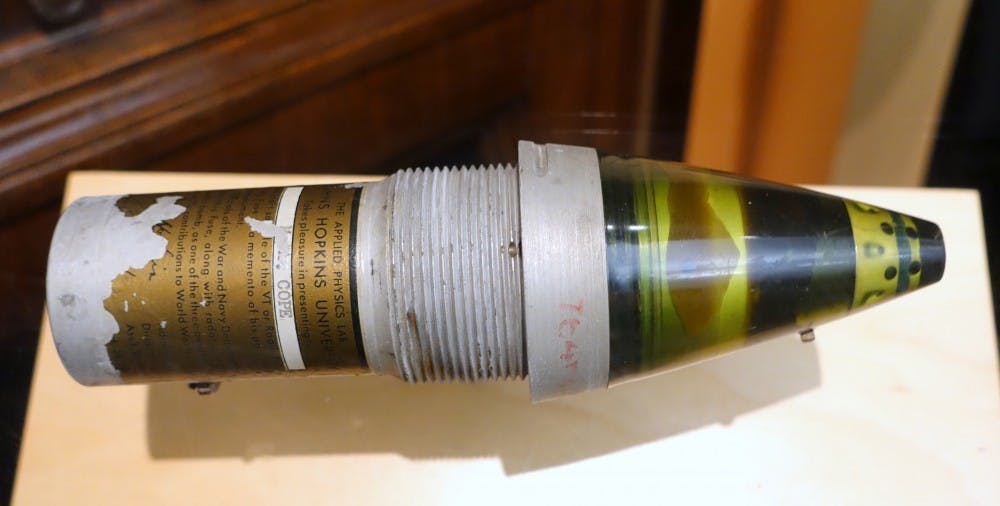In 1993, peace activist Philip Berrigan and six other people from the Baltimore Emergency Response Network (BERN) protested the Johns Hopkins Applied Physics Laboratory’s (APL) nuclear weapons program by spreading ashes on the ground to symbolize the victims of warfare, as well as handing out leaflets. Berrigan and his fellow activists were arrested. John Wilhelm, the APL spokesperson, responded to the events in The Baltimore Sun by saying, “We really don’t have a comment on today’s events. It’s a periodic occurrence.”
Wilhelm was correct: Throughout the 1990s and into the early 2000s, radical protests at the APL were almost commonplace. BERN would often drop banners from the APL roof. According to “The Death Lab” by Max Obuszewski, activists once dropped a banner from the Milton S. Eisenhower library on the Homewood campus. They were arrested on multiple occasions for trespassing while handing out leaflets that asked APL employees to publicly repudiate the APL’s military research.
During a graduation ceremony, activists (with the help of a graduate student) gained access to a third floor office near the commencement stage and unfurled a banner while chanting anti-APL slogans before quickly getting arrested, along with the helpful grad student. They blocked entrances to the APL on multiple occasions, and once, three activists slipped into the APL director’s office and taped a blood-soaked copy of the Nuremberg principles on the door.
Unfortunately, despite these brave and impressive actions, the APL has only become increasingly militarized in the past 20 years, with little fanfare. It can be very difficult to obtain information from the APL and Hopkins (see the 2013 article “Following the path of drones from Obama’s hit list to Johns Hopkins University” in the City Paper for an example).
Our pernicious concept of violence allows us to constantly hand-wring about the violence of the nearby 7/11 being robbed but look the other way when our school’s laboratory is busy making machines that kill innocent children in far-off lands. The question surrounding this problem: How much do we know about our University, and how much do we want to know moving forward?
The cherry on top of the APL’s dedication to fulfilling its nickname “Death Lab” (coined by Berrigan) is a $93 million contract signed in July of this year with the Air Force Nuclear Weapons Center. The contract states that the APL will be involved with “specialized engineering, research and development requirements for the U.S. nuclear arsenal” including “planning, strategic analysis, studies of air-delivered and ground-based nuclear weapons capabilities, and command-and-control communications.”
Funnily enough, I didn’t see an article on The Hub about their new venture.
The last wave of anti-militarization on campus was in 2011-2013 with the campus organization the Human Rights Working Group (HRWG). The group did have several successful actions, such as projecting images of drone victims with the captions “JHU Research At Work: Reckless, Wrong, Illegal” onto Shriver Hall when General Stanley McChrystal spoke as part of the Foreign Affairs Symposium and having a satire booth at the 2013 Spring Fair recruiting people to work in drone research (“Is a career in drone warfare your flight pattern for success?”).
While HRWG was accomplished, it failed to achieve clarification from the University regarding the RISE@APL program, which was launched in 2014. The RISE@APL program allows undergraduate and graduate students the opportunity to perform research at the APL. According to the program’s website, at least one student has worked with weapons development, specifically the Air and Missile Defense Program.
RISE@APL held a major recruitment event this past Monday. While it is clear that undergraduates are permitted in weapons research, it is unclear if they are permitted in the research connected to the nuclear weapons program with the Air Force.
So where do we go from here? The impressive efforts of protesters have failed to slow down the militarization of the APL. To be fair, staring at the APL is like staring at Goliath: In fiscal year 2014, the APL spent $1.254 billion in total research and development expenditures. Of that, $1.214 billion was federally funded according to the article “Johns Hopkins leads U.S. in research spending for 36th year in a row” on The Hub. Most Hopkins students seem either ignorant or indifferent towards the APL. The few articles about the APL in The News-Letter read like sycophantic devotions or copy-and-pasted press releases. For the worst offender, see “JHU Applied Physics Laboratory critical for nation’s defense” by Francesca Peretti from 2006.
However, regardless of how insurmountable the task is, we must continue to speak out and challenge the generally unchallenged APL “Death Lab.” Undergraduate engineers should think twice about doing weapons research. We should ensure that the research weighs heavily upon the administration’s and Board of Trustees’ conscience, if it exists. We must attempt to surmount the insurmountable, lest we find ourselves deeply complicit in a machine that churns out death and destruction year after year after year.
Emeline Armitage is a senior International Studies, Latin American studies and Spanish major. She is from Cleveland.





